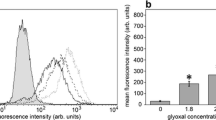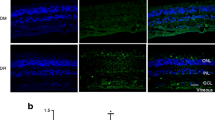Abstract
Background. The accumulation of advanced glycation end products (AGEs) in retinal cells is known to be associated with the risk of diabetic retinopathy. To develop a model of AGE-related metabolic stress in retinal organ cultures, we investigated the accumulation of a typical glycoxidation product (Nε-[carboxymethyl] lysine [CML]) and its possible pro-apoptotic effects on different retinal cell populations.
Methods. Retinal organ cultures (rat) were kept for 9 h in the Ames medium containing 0 (control), 5, 25, 50, 150, 300 and 800 µM glyoxal. The expression of bax, active caspase-3, and the accumulation of CML were studied by using immunohistochemistry after the paraffin embedding of retinal explants. Apoptosis was studied using the terminal deoxynucleotidyl transferase-mediated dUTP digoxigenin nick end labeling (TUNEL) test and electron microscopy. Alpha lipoic acid (α-LA), sodium metavanadate (NaVO3), N-acetylcysteine (NAC), aminoguanidine (AG), and nicotinamide (NA) were used to influence glyoxal effects in organ cultures.
Results. In cultured normal non-diabetic retinae, small amounts of CML and the apoptosis-promoting factors bax and active caspase-3 were present. CML, bax and active caspase-3 increased after incubation with glyoxal. Incubation with glyoxal (<300 µM, 9 h) increased apoptotic events in all layers. At low glyoxal concentrations, we found a graded sensitiveness of the different layers: at 25 µM 39.4% in GCL, 28.2% in INL, 11.9% in ONL. After 800 µM glyoxal, approximately 50% of the cells in all layers of the retina were apoptotic. In the ONL, this ratio was reduced by NaVO3 (17%), by AG (27%), by NA (24.8%), by NAC (25.2%), and by α-LA (33.5%). In the INL, AG (25.9%) produced the best result. In the GCL, NAC, NaVO3 and AG reduced apoptosis. A-LA had no significant protective effect.
Conclusion. The glyoxal-induced rapid formation of CML shows the ability of our retina model to simulate AGE-related effects in vitro. The dose-dependent expression of apoptosis-promotor molecules indicates that the apoptosis-inducing machinery starts in most retinal cells within 9 h. The neurotoxicity of glyoxal-induced AGE formation was shown by the significantly increased rate of cell death in the retina. The significant decrease of apoptotic events (P<0.01) indicates that antioxidants and AGE formation blocker can exert a differentiated cytoprotection for each of the retinal cell layers.
Similar content being viewed by others
Author information
Authors and Affiliations
Additional information
Electronic Publication
Rights and permissions
About this article
Cite this article
Reber, F., Geffarth, R., Kasper, M. et al. Graded sensitiveness of the various retinal neuron populations on the glyoxal-mediated formation of advanced glycation end products and ways of protection. Graefe's Arch Clin Exp Ophthalmol 241, 213–225 (2003). https://doi.org/10.1007/s00417-002-0528-1
Received:
Revised:
Accepted:
Issue Date:
DOI: https://doi.org/10.1007/s00417-002-0528-1




